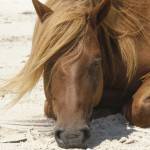Management Practices to Minimize Colic

Eliminating colic completely from the inventory of equine health concerns is unrealistic despite continued research efforts of scientists worldwide. However, reducing the occurrence of colic is possible when sound management practices are followed.
Match the horse’s normal diet. Feed a high-quality roughage diet with very few soluble carbohydrates. The bulk of the diet should be roughage (hay or pasture), which should average 1-2% of the body weight per day. If grain must be fed to meet energy requirements, at least 50% of the total diet should be roughage. Fat may be added to the diet to increase the caloric density of the grain without causing the digestive problems associated with overfeeding carbohydrates. Fat can be added in the form of corn oil, vegetable oil, or rice bran.
Mimic the horse’s natural feeding schedule. Allowing free-choice hay to horses kept in stalls or paddocks will mimic the horse’s grazing behavior. Overweight horses should be fed 1% of their body weight, and this can be divided into two or three feedings. Horses are creatures of habit, so feeding at approximately the same times every day will help decrease the risk of colic. Feeding grain without access to roughage between the feedings has been shown to increase the concentration of gastric acid and bile, which can cause severe gastric or duodenal ulceration within 14 hours of fasting. Feeding small amounts of grain throughout the day will help decrease the carbohydrate load on the large intestine as long as the grain is kept to 3 pounds (1.3 kilograms) or less per meal.
Allow the horse daily or near-daily exercise. Colic risk is lower for horses on pasture. If full pasture turnout is not an option, the horse should be turned out daily for as long as possible. If no turnout is available, the horse should be ridden, walked, or otherwise exercised daily.
Make diet alterations gradually. Make dietary changes over a period of one to two weeks. Concentrate can be increased by one-half pound (0.23 kilogram) per day. When changing hay, mix the old hay with the new to allow the gastrointestinal tract to adapt. If the horse is to be confined to a stall due to an injury, decreasing the grain will help prevent colic.
Provide good-quality feedstuffs. All feeds offered to horses and ponies should be the highest quality. Avoid feeding any concentrate that is spoiled or contaminated. Horses will not often eat feed that is spoiled, but all suspected rancid feed should be discarded even if horses will consume it. Do not assume that feed is free of contamination simply because horses will eat it. The remains of rodents or other animals (mice, snakes, etc.) should deem any feed unsuitable for consumption.
Hay should be leafy and soft with fine stems. Grass and legume hays harvested before maturity are more readily digested by horses and ponies and are therefore less likely to cause colic. Some owners are under the erroneous assumption that obese or laminitic horses should be given mediocre or poor-quality hay because overfeeding has been destructive to their well-being in the past. Instead, such horses should be fed the best grass hay possible doled in judicious portions.
Alfalfa (lucerne) hay should be thoroughly inspected for blister beetles. As few as two or three beetles can induce colic or colitis in an otherwise healthy horse. Purchasing alfalfa (lucerne) hay from a reputable dealer is one way to avoid blister beetle poisoning, but because beetles usually swarm and infestation is hit-and-miss, inspection of every bale is worthwhile.
Use only feeds formulated for horses. Cattle, pig, and chicken feeds are not suited for consumption by horses. The nutritional requirements of horses are completely different than those of other species. A far more important reason for avoiding feeds formulated for other species exists. Certain additives in these feeds are poisonous to horses. For example, monensin, a common ingredient in cattle and poultry feeds, is highly toxic to horses and may predispose a horse to colic, general weakness, and death.
Allow free access to fresh water. Horses should have clean water available to them at all times. Particular attention should be paid to water consumption in the winter. Some horses drink less as water temperatures fall to near freezing. If this is the case, warm water should be offered to the horse at least twice a day during periods of persistent cold temperatures (read more). Allowing the horse the opportunity to drink during transport and long-term exercise may also prevent an episode of colic.
Put the horse on a regular deworming program. The cost of deworming is minimal, especially when compared to the benefits. Consult a veterinarian when devising a deworming program as this individual is most likely aware of the primary parasitic threats in the region. Regular deworming may also save on out-of-pocket feed expenses because the feed will be utilized for sustaining the body processes of the horse and not the life cycles of internal parasites.
Schedule regular dental care. Annual dental examinations will ensure that feed is chewed properly and maximal nutrients are delivered to the gastrointestinal tract for absorption. Dental abnormalities can severely hamper the mechanical breakdown of grains, particularly unprocessed cereal grains such as whole oats. If teeth are left unchecked, sharp points may develop on the molars, and these may cause extreme discomfort to the horse. Some horses may eventually refuse to eat due to the pain caused by dental abnormalities.
Manage the environment. Keep the horse’s environment free of debris. Ingested foreign materials such as rubber or baling twine can cause colic by blocking the digestive tract. Minerals and other material may surround an object and form a stone that can lead to blockage. Although most horses will not eat toxic plants if other food is available, owners should monitor the pasture and hay bales for suspect plants.
Read more from Advances in Equine Nutrition III.








